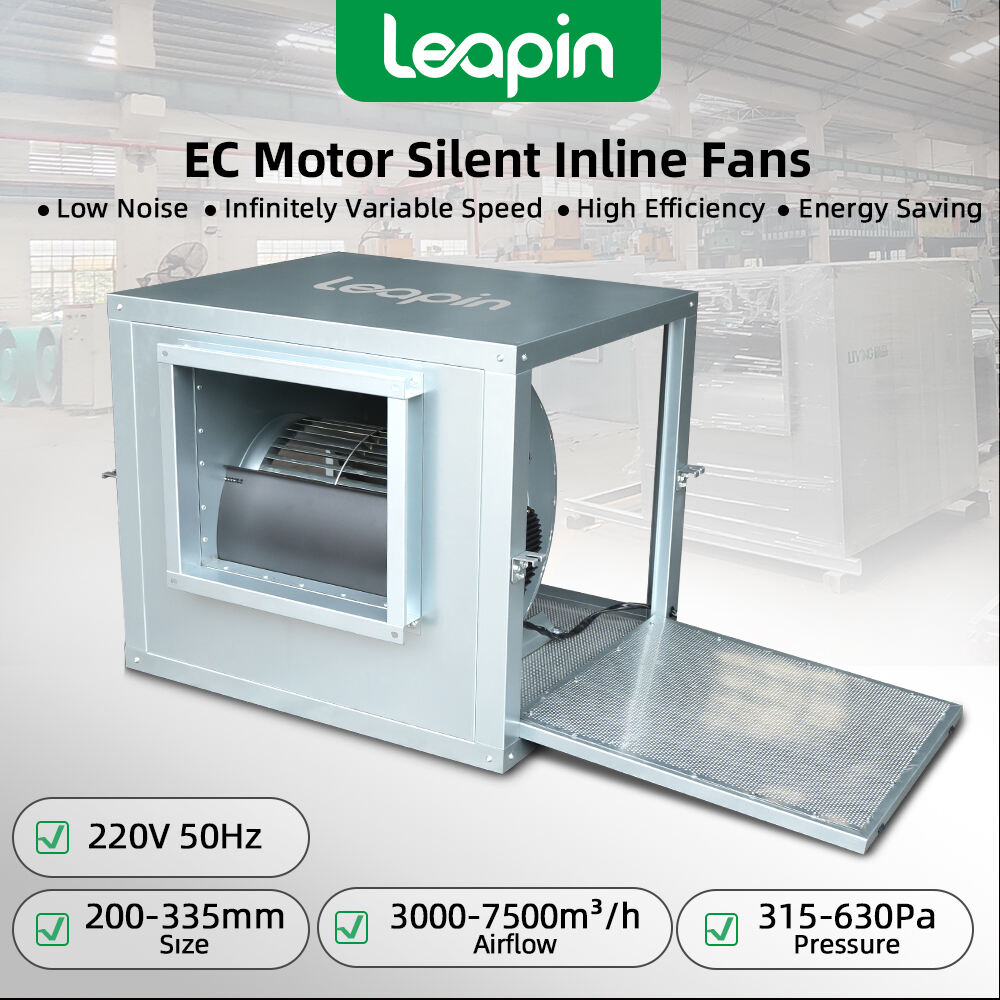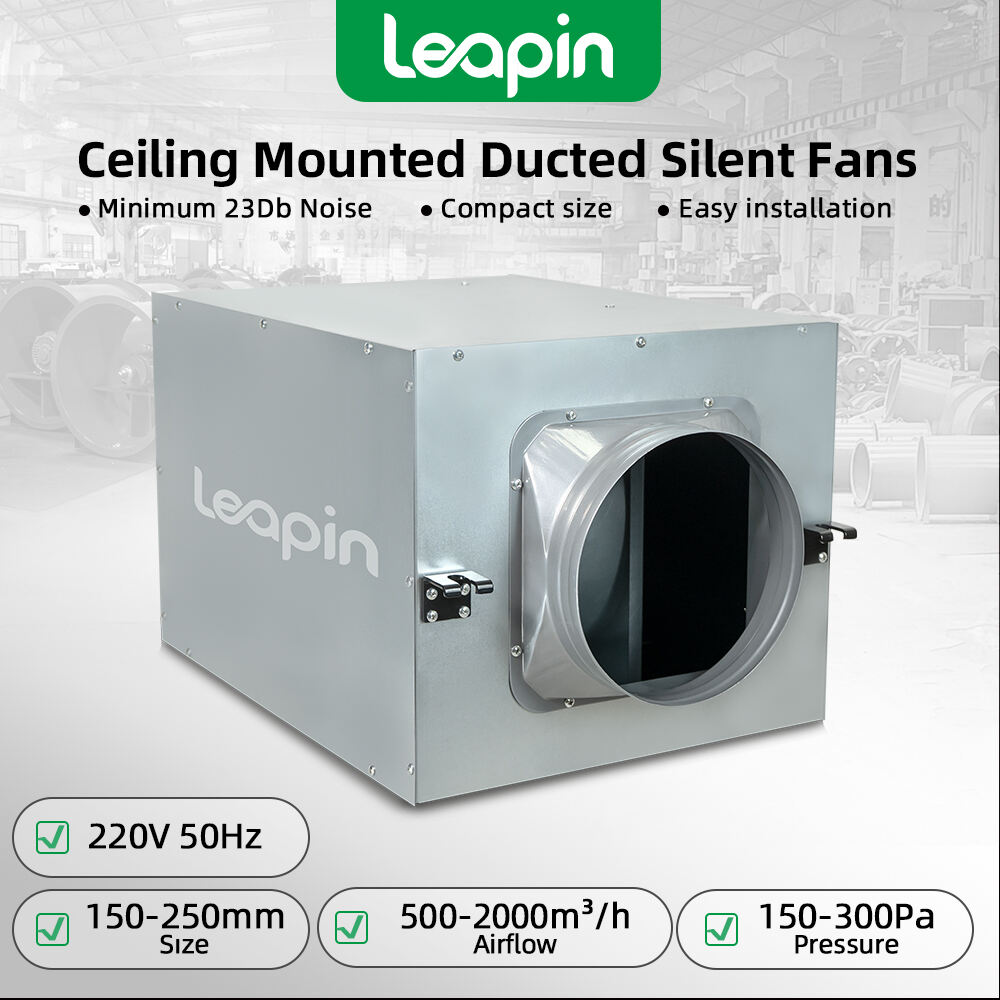ইনলাইন সেন্ট্রিফিউগাল ফ্যানের ডিজাইন এবং অ্যাপ্লিকেশন বুঝতে
ইনলাইন সেন্ট্রিফিউগাল ফ্যানের প্রধান ডিজাইন উপাদান
সেন্ট্রিফিউগাল বায়ুপ্রবাহ ডায়নেমিক্স এবং স্পাইরাল কেসিং ডিজাইন
সেন্ট্রিফিউগাল বায়ুপ্রবাহের তত্ত্বগুলি ফ্যানে বায়ু গতির দক্ষতা বাড়ানোর জন্য খুবই গুরুত্বপূর্ণ। একটি সেন্ট্রিফিউগাল বায়ুপ্রবাহ ফ্যানে, ইমপেলার বায়ুকে বাইরে ঠেলে দেয়ার জন্য চাপের পার্থক্য তৈরি করে, যা ফলস্বরূপ দক্ষ বায়ু পরিবর্তন ঘটায়। এই পদ্ধতিটি নির্দিষ্ট বায়ুপ্রবাহ এবং উচ্চ স্থির চাপের পরিবেশের প্রয়োজনীয়তার জন্য বিশেষভাবে গুরুত্বপূর্ণ। স্পাইরাল কেসিং ডিজাইন এই প্রক্রিয়াকে আরও সুনির্দিষ্টভাবে নিয়ন্ত্রণ করে। কেসিংের গঠন ফ্যানের সামগ্রিক কার্যক্ষমতা বাড়ায় ডায়নামিক চাপকে স্থির চাপে রূপান্তর করে। এছাড়াও, কেসিংের ডিজাইন শব্দ হ্রাসের জন্য গুরুত্বপূর্ণ ভূমিকা পালন করে, যা ফ্যানের চালু কর্মকারিতা বাড়ায়। টার্বুলেন্ট বায়ুপ্রবাহ কমানোর মাধ্যমে স্পাইরাল কেসিং শব্দহীন চালু কর্মকারিতা নিশ্চিত করে, যা শব্দ স্তরের উপর দৃষ্টি রাখা প্রয়োজনীয় পরিবেশের জন্য এই ফ্যানগুলি আদর্শ করে তোলে।
এইসি মোটর প্রযুক্তি শক্তি অপটিমাইজেশনের জন্য
এইসি (ইলেকট্রনিক্যালি কমিউটেড) মোটরগুলি ফ্যান প্রযুক্তির এক বিশেষ উন্নতি, যা ইনলাইন সেন্ট্রিফিউগাল ফ্যানের জন্য গুরুত্বপূর্ণ সুবিধা প্রদান করে। এই মোটরগুলি শক্তি-কার্যকারী হিসেবে ডিজাইন করা হয়েছে, উন্নত ইলেকট্রনিক নিয়ন্ত্রণ ব্যবহার করে কার্যকারিতা নিয়ন্ত্রণ করতে এবং অপচয় কমাতে। গবেষণা দেখায়েছে যে এইসি মোটরগুলি ঐতিহ্যবাহী এসি মোটরের তুলনায় শক্তি বাচাতে পারে পর্যাপ্ত ৩০% পর্যন্ত, যা বিভিন্ন অ্যাপ্লিকেশনে শক্তি অপটিমাইজেশন প্রচার করে। এইসি মোটর প্রযুক্তির একটি প্রধান সুবিধা হল এর চলক গতি নিয়ন্ত্রণের ক্ষমতা। এই বৈশিষ্ট্যটি কাস্টমাইজড অপারেশন অনুমতি দেয়, বাস্তব সময়ে ফ্যানের কার্যকারিতা আবশ্যক প্রয়োজনের অনুযায়ী পরিবর্তন করে। এই প্রসারিত সুবিধা অযথা শক্তি ব্যবহার কমাতে এবং ডিমান্ড অনুযায়ী ব্যবহার অপটিমাইজ করে সিস্টেমের জীবনকাল বাড়াতে সাহায্য করে।
ডাবল এয়ার ইনলেট ফোরওয়ার্ড-ইনক্লাইন্ড ইমপেলার
ডাবল এয়ার ইনলেট ফোরওয়ার্ড-ইনক্লাইন্ড ইমপেলার দক্ষ এয়ারফ্লো সিস্টেম ডিজাইনের একটি গুরুত্বপূর্ণ উপাদান। এই বিশেষ ডিজাইন ফ্যানকে দুটি দিক থেকে এয়ার টানতে দেয়, এয়ারফ্লো ডায়নেমিক্সকে উন্নয়ন করে এবং সমগ্র দক্ষতাকে উন্নত করে। ফোরওয়ার্ড-ইনক্লাইন্ড ব্লেডগুলি এই মেকানিজমের কেন্দ্রস্থল, চাপ উৎপাদনে প্রভাব ফেলে এয়ার মুভমেন্টের জন্য একটি স্ট্রিমলাইনড পথ তৈরি করে, ফলে ফ্যানের পারফরম্যান্স বাড়ায়। এই ধরনের ডিজাইন ঐতিহ্যবাহী ইমপেলারের তুলনায় শক্তি দক্ষতায় আশ্চর্যজনক উন্নয়ন তৈরি করে। একটি সহজ এয়ারফ্লো পথ তৈরি করে এবং প্রতিরোধ কমাতে এই ইমপেলারগুলি শক্তি খরচ কমায়, এটি আধুনিক ভেন্টিলেশন সিস্টেমের জন্য একটি ব্যবহার্য বাছাই এবং সময়ের সাথে কম চালু খরচের অবদান রাখে।
এইচভিএস সিস্টেম এবং একচেঞ্জার ডাক্ট ফ্যান ইন্টিগ্রেশন
ইনলাইন সেন্ট্রিফিউগাল ফ্যান এইচভিএসি সিস্টেমে একটি গুরুত্বপূর্ণ ভূমিকা পালন করে, বিভিন্ন জায়গায় দক্ষ বায়ু বিতরণ নিশ্চিত করে। এই ফ্যানগুলি একসাথে হোয়েজ ডাক্ট সিস্টেমের সাথে অত্যন্ত সহজে কাজ করে, চালু খরচ কমিয়ে শক্তি ব্যবহারকে অপটিমাইজ করে। উদাহরণস্বরূপ, তাদের বাণিজ্যিক পরিবেশে একত্রিত করা এর মাধ্যমে সামগ্রিক বায়ু গুণগত মান উন্নয়ন করা যেতে পারে এবং শক্তি ব্যয় কমানো যায়। একটি কেস স্টাডি-তে, একটি বড় অফিস ভবন হোয়েজ ডাক্ট সঙ্গে সেন্ট্রিফিউগাল ফ্যান একত্রিত করেছিল, যা ১৫% শক্তি বাঁচানোর ফলাফল দেখায়। এই সফল একত্রিত করণ এইচভিএসি সিস্টেমে হোয়েজ ডাক্ট ফ্যান ব্যবহারের গুরুত্বপূর্ণ সুবিধা প্রদর্শন করে যা শক্তি দক্ষতা এবং ব্যবহারকে উন্নয়ন করে।
বিশেষ ব্যবহার: রেডন মিটিগেশন এবং হাইড্রোপনিক বায়ু বিতরণ
ইনলাইন সেন্ট্রিফিউগাল ফ্যান রেডন মিটিগেশন এবং হাইড্রোপনিক ভেন্টিলেশনের মতো বিশেষ অ্যাপ্লিকেশনে জীবনযোগ্য হয়। ইনলাইন রেডন ফ্যান রেডন গ্যাসের মাত্রা কমানোর জন্য একটি গুরুত্বপূর্ণ ভূমিকা পালন করে, যা আন্তঃভৌতিক বায়ু গুণবৎ সুরক্ষা দেয়। এই ফ্যানগুলি অপ্রয়োজনীয় গ্যাস কার্যকরভাবে ভেন্ট করতে ডিজাইন করা হয়েছে, যা বায়ু সুরক্ষার বিষয়ে ঘরের মালিকদের মনে শান্তি দেয়। হাইড্রোপনিক্স খাতে, সেন্ট্রিফিউগাল ফ্যান অপ্টিমাল গ্রোথ শর্তাবলী রক্ষা করতে মূল্যবান। তারা নিশ্চিত করে যে গাছেরা স্বাস্থ্যকর বৃদ্ধির জন্য যথেষ্ট বায়ুপ্রবাহ পায়। শিল্পীয় পরিসংখ্যান নির্দেশ করে যে হাইড্রোপনিক ইনলাইন ফ্যান ফসলের উৎপাদনশীলতা সর্বোচ্চ ৩০% বাড়িয়ে তুলতে পারে, যা এদের কার্যকারিতা বাড়ির এবং বাণিজ্যিক সেটিংগে প্রমাণ করে।
অফিস এবং বাসা জোনে নিম্ন-শব্দ প্রয়োজন
কম শব্দের চালনা অফিস এবং বাসা এলাকায় ব্যবহৃত ইনলাইন সেন্ট্রিফিউগাল ফ্যানের জন্য গুরুত্বপূর্ণ। শান্ত পরিবেশের প্রয়োজনীয়তা ফ্যানের ডিজাইনে উন্নয়নের দিকে নিয়ে গেছে, যা শব্দ হ্রাসের প্রযুক্তির উপর দৃষ্টি নিবদ্ধ করেছে। এই উদ্ভাবনগুলি নিশ্চিত করে যে ফ্যানের চালনা এমন কম শব্দ স্তরে থাকবে যা এই জায়গাগুলিতে প্রয়োজন। বিশেষজ্ঞরা মত দেন যে ঘরে ৩৫ ডিবি এবং অফিসে ৪৫ ডিবি ছাড়িয়ে যেতে পারে না শব্দের স্তর যা আদর্শ সুখের জন্য প্রয়োজন। শব্দ-হ্রাসক উপাদান এবং কৌশলগত কেসিং নির্মাণের সাথে, এই ফ্যানগুলি শিল্পের উচ্চ বাঁধনের প্রতি আঙ্গিক করে যে তারা শান্ত এবং আরামদায়ক বাসা এবং কাজের পরিবেশ তৈরি করতে চায়, বাণিজ্যিক এবং বাসা প্রয়োগের বিশেষ প্রয়োজনের উপর ভিত্তি করে।
ইনলাইন সেন্ট্রিফিউগাল ফ্যান বনাম অক্সিয়াল ফ্যান: পারফরম্যান্স তুলনা
চাপ উৎপাদন এবং বায়ুপ্রবাহের দিক
ইনলাইন সেন্ট্রিফিউগাল এবং অক্সিয়াল ফ্যান তুলনা করতে গেলে, চাপ উৎপাদন এবং বায়ুপ্রবাহের দিকনির্দেশনা মৌলিক পারফরম্যান্স মেট্রিক। অক্সিয়াল ফ্যানগুলি কম চাপের সাথে বড় আয়তনের বায়ু চালানোতে দক্ষ, অন্যদিকে ইনলাইন সেন্ট্রিফিউগাল ফ্যানগুলি উচ্চ-চাপের বায়ুপ্রবাহ উৎপাদনে পারদর্শী। এই পার্থক্যটি ভিন্ন ব্লেড এবং রোটর ডিজাইনের কারণে ঘটে: অক্সিয়াল ফ্যানগুলি রোটর অক্ষের সমান্তরালভাবে বায়ু ঠেলে, যখন সেন্ট্রিফিউগাল ফ্যানগুলি অক্ষের লম্বভাবে বায়ু চালায়, যা সিস্টেম ডিজাইনের প্রয়োজনে পরিবর্তন আনে। উদাহরণস্বরূপ, উচ্চ চাপে স্থির বায়ুপ্রবাহ রক্ষণাবেক্ষণে সেন্ট্রিফিউগাল ফ্যানের দক্ষতা অনেক সময় অপরিহার্য হয়, যা পারফরম্যান্স ডেটার মাধ্যমে প্রমাণিত হয়েছে যে এটি অক্সিয়াল ডিজাইনের তুলনায় উত্তম Cubic Feet per Minute (CFM) এবং স্থির চাপ মেট্রিক উৎপাদন করে।
ডাক্ট ইনস্টলেশনে স্পেস দক্ষতা
ডাক্তারি সিস্টেমে ব্যবহৃত ইনলাইন সেন্ট্রিফিউগাল ফ্যান স্পেস ইফিশিয়েন্সের দিকে গুরুত্বপূর্ণ সুবিধা প্রদান করে। তাদের ছোট ডিজাইন কম জায়গায় ইনস্টলেশনের অনুমতি দেয়, অনেক সময় এটি সম্ভব করে যে বিফল হওয়া ছাড়াই উপলব্ধ স্থান ব্যবহার করা যায়। মূল ইনস্টলেশন বিবেচনা ফ্যানের আকার ডাক্ট জ্যামিতির সাপেক্ষে এবং যথেষ্ট বায়ুপ্রবাহ পরিষ্কার করার প্রয়োজন। উদাহরণস্বরূপ, বাণিজ্যিক ভবনগুলি ছাদ বা দেয়ালের ডাক্টে সীমিত স্থানের সর্বোত্তম ব্যবহার করতে এই ফ্যানগুলি ব্যবহার করে, বিদ্যমান আর্কিটেকচারের সাথে ইন্টিগ্রেট হয় এবং বেন্টিলেশনের দক্ষতা বাড়ায়।
দীর্ঘ দূরত্বের বায়ু সরবরাহের জন্য উপযুক্ত
দীর্ঘ দূরত্বের বায়ু সরবরাহের ক্ষেত্রে, ইনলাইন সেন্ট্রিফিউগাল ফ্যান তাদের অক্সিয়াল প্রতিদ্বন্দ্বীদের তুলনায় উত্তম পারফরম্যান্স প্রদর্শন করে। এদের ইঞ্জিনিয়ারিং ব্যাপক ডাক্ট দৈর্ঘ্যের জন্য ধ্রুব বায়ুপ্রবাহ এবং চাপ রক্ষা করতে সক্ষম, যা বড় গোদাম এবং শিল্পীয় পরিবেশের মতো অ্যাপ্লিকেশনের জন্য গুরুত্বপূর্ণ। সেন্ট্রিফিউগাল ফ্যান ধ্রুব চাপের মাত্রা রক্ষা করে, যেন বেগের কোনো ক্ষতি ছাড়াই বায়ু তার উদ্দেশ্যস্থানে পৌঁছে। বাস্তব জীবনের উদাহরণ অসংখ্য, বিশেষ করে HVAC সিস্টেমে, যেখানে সেন্ট্রিফিউগাল ফ্যান ব্যাপক বায়ু বিতরণের জন্য ব্যবহৃত হয় বিশাল জায়গাগুলোতে, যা তাদের শক্তিশালী প্রকৃতি এবং দীর্ঘ দূরত্ব অতিক্রমের ভিত্তিতে বিশ্বস্ততার উদাহরণ দেয়।
পণ্য প্রদর্শন: উন্নত ইনলাইন সেন্ট্রিফিউগাল সমাধান
ইসি মোটর সাইলেন্ট ইনলাইন ফ্যান সিডিসি-ই সিরিজ
সিডিসি-ই শ্রেণীর ফ্যানগুলি তাদের উন্নত ইসি মোটর প্রযুক্তির জন্য বিখ্যাত, যা নিরব চালনা এবং আশ্চর্যজনক শক্তি কার্যকারিতা গ্রহণ করে। এই ফ্যানগুলি দ্বিগুণ বায়ু প্রবেশ সম্পন্ন অগ্রভাগ ঝুড়ি, উচ্চ-গুণবत্তার বেয়ারিং, এবং কার্যকর শব্দ নিরোধক বাহিরের বক্স সহ সজ্জিত, যা তাদের কার্যালয়, সভা ঘর, এবং শয়ন ঘরের মতো নিরব পরিবেশের প্রয়োজনীয়তার জন্য আদর্শ করে। সিডিসি-ই শ্রেণী অপটিমাল বায়ুপ্রবাহ বজায় রাখতেও দক্ষ, কম শক্তি ব্যবহারের সাথে, যা ব্যবসার জন্য কম চালু খরচের অবদান রাখে। আমাদের অনেক গ্রাহকই শক্তি বাঁচানো এবং নিরব পারফরম্যান্সের সন্তুষ্টি শেয়ার করেছেন যা তারা সিডিসি-ই শ্রেণীর ফ্যান ইনস্টল করার পর অর্জন করেছেন।
ডাক্ট সাইলেন্ট কেবিনেট বক্স ইনলাইন ফ্যান ডিপি টি সিরিজ
ডিপিটি সিরিজে ডুয়াল-সাকশন ডায়েক্ট-কাপলড মোটর ডিজাইন অন্তর্ভুক্ত রয়েছে, যা নিম্ন শব্দ এবং দক্ষ বায়ু প্রবাহন গ্রহণ করে। এর স্ট্রেইট-থ্রু ডাক্ট ডিজাইন এবং ১৮০° বায়ু আউটলেট দিক, বাস্তবায়ন এবং বায়ু প্রবাহনের জন্য বাড়ি এবং বাণিজ্যিক সেটিংসে দীর্ঘ দূরত্বের জন্য পারফেক্ট। এই ফ্যানগুলি এমন পরিবেশের জন্য আদর্শ যেখানে গোপনীয়তা এবং শান্ত চালুনি প্রধান। শিল্প বিশেষজ্ঞরা এর দৃঢ় ডিজাইন এবং কার্যকর পারফরম্যান্সের জন্য সহজেই উচ্চ মূল্যায়ন করেন, অনেক সময় ফ্যানের ক্ষমতা উল্লেখ করে যে অনবচ্ছিন্ন বায়ুপ্রবাহ প্রদান করতে পারে শব্দের মাত্রা কমিয়ে।
ইনস্টলেশন এবং রক্ষণাবেক্ষণের সেরা প্রaksi
স্পেস-কনস্ট্রেইন্ড মাউন্টিংের জন্য কম্প্যাক্ট ডিজাইন
ইনলাইন সেন্ট্রিফিউগাল ফ্যানের কম্প্যাক্ট ডিজাইন তাদের স্পেস-কনস্ট্রেইনড পরিবেশে ইনস্টলেশনের জন্য আদর্শ করে তোলে। এই ফ্যানগুলি ইনস্টল করার সময় উপলব্ধ স্পেসটি বিবেচনা করা গুরুত্বপূর্ণ, যেন পারফরম্যান্স কমাতে না হয়ে ফ্যানটি পুরোপুরি মিলে যায়। সঠিক ফ্যান মডেল নির্বাচনের জন্য এখানে কিছু টিপস রয়েছে:
- উপলব্ধ এলাকা মেপুন : ফ্যান নির্বাচনের আগে ইনস্টলেশন এলাকা মেপুন যেন ফ্যান এবং ডাক্টওয়ার্কের জন্য যথেষ্ট স্থান থাকে।
- যোগ্য মডেল নির্বাচন করুন : টিউবুলার ইনলাইন সেন্ট্রিফিউগাল ফ্যানের মতো কম্প্যাক্ট মডেল নির্বাচন করুন, যা স্পেস সেভ করতে এবং উচ্চ পারফরম্যান্স প্রদান করতে ডিজাইন করা হয়েছে।
- সফল ইনস্টলেশন : ইনলাইন ফ্যানগুলি ছোট বাড়ির ব্যাথরুমের মতো সেটিংয়ে সফলভাবে ইনস্টল করা হয়েছে, যা সঙ্কীর্ণ স্পেসে অসাধারণ পরিবর্তনশীলতা প্রদর্শন করেছে।
সহজ সার্ভিস এক্সেসের জন্য অ্যাটাচেবল প্যানেল
অনলাইন সেন্ট্রিফিউগাল ফ্যানে ব্যবহৃত পৃথককরণযোগ্য প্যানেলসমূহ রক্ষণাবেক্ষণ প্রক্রিয়াকে সহজ করে এবং গুরুতরভাবে ডাউনটাইম হ্রাস করে। এই প্যানেলগুলি ফ্যানের আন্তর্বর্তী উপাদানগুলির সহজ অ্যাক্সেস সম্ভব করে, যা দ্রুত পরিদর্শন এবং সেবা দেওয়ার সুবিধা দেয়। ফ্যান ইনস্টলেশন ডিজাইন করার সময় রক্ষণাবেক্ষণের উপর জোর দেওয়া অত্যাবশ্যক:
- সার্ভিস এক্সেস : পৃথককরণযোগ্য প্যানেল থাকায় পরিষ্কার করা এবং অংশ প্রতিস্থাপন করা আরও সহজ হয়, যা কার্যকারিতা রক্ষা করতে গুরুত্বপূর্ণ।
- রক্ষণাবেক্ষণের মধ্যবর্তী সময় : নিয়মিত রক্ষণাবেক্ষণ, সাধারণত ছয় মাস পর পর, ফ্যানগুলির অপটিমাল পারফরম্যান্স বজায় রাখতে পরামর্শ দেওয়া হয়।
- ব্যবহারের সহজতা : পৃথককরণযোগ্য প্যানেল ব্যবহার করে ব্যবসাগুলি ব্যাঘাত কমাতে পারে এবং ফ্যানের জীবনকাল বাড়িয়ে তুলতে পারে।
কঠিন পরিবেশে গ্যালভানাইজড কেসিং দৈর্ঘ্যকালীনতা
কঠিন পরিবেশে, বিশেষ করে গ্যালভানাইজড কেসিং করোশনের বিরুদ্ধে দীর্ঘ জীবন এবং দৃঢ়তা প্রদান করে। এই কেসিংগুলি দীর্ঘ জীবন বাড়ায় এবং চ্যালেঞ্জিং সেটিংসেও সামঞ্জস্যপূর্ণ পারফরম্যান্স নিশ্চিত করে:
- গ্যালভানাইজেশনের ফায়াব : গ্যালভানাইজড কেসিংস করোশনের ঝুঁকি প্রতিবন্ধ করে এবং দীর্ঘায়ু এবং নির্ভরযোগ্য চালনা উৎসাহিত করে।
- অ্যাপ্লিকেশন : উচ্চ আর্দ্রতা বা রাসায়নিক ব্যবহারের পরিবেশে এই ফ্যানগুলি প্রয়োজন, যা সময়ের সাথে দৈর্ঘ্য নিশ্চিত করে।
- প্রশিক্ষণ সমর্থন : গবেষণা দেখায় যে গ্যালভানাইজড উপাদানগুলি বিভিন্ন পরিবেশগত চাপের মুখোমুখি হওয়ার ক্ষমতা রয়েছে, যা তাদের শিল্পকার্যে ব্যবহারের জন্য উপযুক্ত এবং পরিচালনা বিরতির বিরুদ্ধে রোবাস্ট সুরক্ষা প্রদান করে।
এই সেরা অনুশীলনগুলি অন্তর্ভুক্ত করা শুধুমাত্র ফ্যানের কার্যকারিতা নিশ্চিত করে বরং ইনলাইন সেন্ট্রিফিউগাল সমাধানের জীবন বর্ধন করে, যা চিন্তিত ইনস্টলেশন এবং রক্ষণাবেক্ষণ পদক্ষেপের গুরুত্ব উল্লেখ করে।

 EN
EN
 AR
AR
 FR
FR
 RU
RU
 ES
ES
 TL
TL
 ID
ID
 VI
VI
 TH
TH
 MS
MS
 BN
BN



